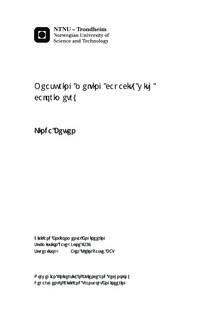Measuring melting capacity with calorimetry
Master thesis
Permanent lenke
http://hdl.handle.net/11250/233023Utgivelsesdato
2014Metadata
Vis full innførselSamlinger
Sammendrag
Road salting is an important aspect of winter maintenance. There has been an increase in the usage of salt in later years to keep the road safe and accessible. It is a desire to reduce the amount of salt due to environmental aspects. To achieve better practices for winter maintenance it is necessary to obtain more knowledge about the different properties of salt. The motivation for this thesis is to develop a better method for determining the melting capacity for salt, which is an important property in deicing. The purpose of this thesis is to develop and test a calorimeter. The calorimeter used in this thesis is build earlier, so the objective of this thesis is to determine the accuracy of the calorimeter for ice melting experiments. The calorimeter is able to measure the heat necessary to melt a given amount of ice, by using thermodynamic properties. When ice melts in a closed system, the temperature decreases. This happens because the energy within the system is used to break the bonding between the ice molecules. To counteract this temperature fall, the calorimeter adds heat to the system. With the premise that the initial and final temperature is the same, the energy added to the system is equal the amount of energy necessary to melt a given amount of snow. The calorimeter consists of an isolated reactor, a heater, a cooler and a computer that registers the temperatures and regulates the heat added to the reactor. To test the accuracy of the calorimeter some initial parameters had to be determined. These parameters include heat capacity of the reactor, heat leakage and heat from stirrer. The most extensive testing to evaluate the accuracy to predict the amount of ice melted, was done with ice melting in pure water. A few test was performed at cold temperatures with salt solution of NaCl.In room temperature, with no heat leakage, the accuracy of the measurements was found to be 93,5%. The correlation between measured and theoretical values was good, and the measured value was consequently lower than the theoretical value. If only tests performed with an amount of ice of 45 g or higher was included the accuracy was almost 95%. The precision of the test performed at lower temperatures with salt solution turned out to be less accurate, with an accuracy of less than 70 %. This means that the accuracy of the calorimeter is still not satisfactory, but it is potential to improve the measurements further. The biggest uncertainty lays in the heat leakage and it is therefore recommended to place the calorimeter in a cold room. The testing procedure should also be improved to obtain more consistent results, especially regarding cooling time and temperature of the ice samples. The calorimeter has the prospective to investigate the ice melting properties and determine the freezing curve of unknown substances. This is possible if the accuracy and precision of the calorimeter is further improved.
